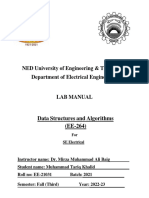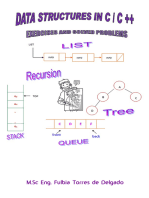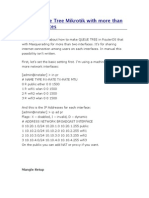0 ratings0% found this document useful (0 votes)
83 viewsAssignment 1 - Introduction To Data Science
Data Science
Uploaded by
lorrainencube175Copyright
© © All Rights Reserved
We take content rights seriously. If you suspect this is your content, claim it here.
Available Formats
Download as PDF, TXT or read online on Scribd
0 ratings0% found this document useful (0 votes)
83 viewsAssignment 1 - Introduction To Data Science
Data Science
Uploaded by
lorrainencube175Copyright
© © All Rights Reserved
We take content rights seriously. If you suspect this is your content, claim it here.
Available Formats
Download as PDF, TXT or read online on Scribd
You are on page 1/ 3
Assignment 1: Introduction to Data Science
Lecture 1: Understanding Data Science, Data Engineering, and Data Analysis
Instructions:
1. Essay (20 points):
○ Write a detailed essay (1000-1500 words) on the differences and
interconnections between Data Science, Data Engineering, and Data Analysis.
○ Include the following sections:
■ Introduction: Define each field and explain their importance in the
context of modern data-driven decision-making.
■ Core Responsibilities: Outline the primary responsibilities and tasks
associated with each role.
■ Tools and Technologies: Discuss the common tools and technologies
used by professionals in each field.
■ Case Studies: Provide real-world examples or case studies illustrating
how these roles collaborate in a project.
■ Conclusion: Summarize the key points and reflect on the future trends in
these fields.
2. Research Project (30 points):
○ Choose a specific industry (e.g., healthcare, finance, retail) and conduct research
on how data science, data engineering, and data analysis are applied within that
industry.
○ Create a report (1500-2000 words) that includes:
■ Introduction: Briefly describe the chosen industry and its relevance.
■ Applications: Detail how each of the three fields contributes to solving
industry-specific problems.
■ Challenges: Identify the key challenges faced by professionals in these
roles within the industry.
■ Innovations: Highlight any innovative solutions or emerging trends.
■ Interviews: Conduct interviews with at least two professionals working in
these fields and include their insights in your report.
■ Conclusion: Reflect on the insights gained from the research and
interviews.
Lecture 2: Introduction to Python
Instructions:
1. Python Coding Assignment (25 points):
○ Write Python code to solve the following problems. Submit your code along with
detailed comments explaining your logic.
a. Data Types and Operations:
■
Create a script that accepts user input for two numbers and performs the
following operations: addition, subtraction, multiplication, division, and
modulus. Display the results.
○ b. Data Structures:
■ Implement a Python program that creates a dictionary of 5 students, each
with a nested dictionary containing their name, age, and grades in three
subjects. Write functions to:
■ Calculate the average grade of each student.
■ Find the student with the highest average grade.
■ Sort the students by their average grades in descending order and
print the sorted list.
○ c. Control Flow and Functions:
■ Develop a function that takes a list of integers and returns a list of prime
numbers from the input list. Include a main block to test your function with
various inputs.
2. Exploratory Data Analysis Project (25 points):
○ Use Python and libraries such as Pandas, NumPy, and Matplotlib to perform an
exploratory data analysis (EDA) on a provided dataset.
○ Dataset: [Provide a link to a dataset or include a sample dataset]
○ Tasks:
■ Load the dataset and display the first 10 rows.
■ Perform basic data cleaning (e.g., handling missing values, correcting
data types).
■ Generate summary statistics for numerical and categorical columns.
■ Visualize the distribution of key variables using appropriate plots
(histograms, box plots, bar charts, etc.).
■ Identify and visualize any correlations between variables.
■ Write a report (800-1000 words) summarizing your findings, including the
insights gained from the EDA and any interesting patterns or anomalies
discovered.
Submission Guidelines:
● Submit all written assignments as PDF documents.
● Submit Python code files (.py) and Jupyter Notebooks (.ipynb) as applicable.
● Include all visualizations and results within your reports.
● Ensure that all submissions are properly formatted and free of grammatical errors.
Grading Criteria:
● Clarity and depth of explanations
● Completeness and correctness of code
● Insightfulness of analysis and reflections
● Creativity and originality in approach
● Proper use of tools and technologies
Deadline:
● 23 Augast at 23:00
Note: Collaboration is encouraged, but each student must submit their own work. Plagiarism will
not be tolerated.
You might also like
- CSE 414 Final Exam Sp13: Sample SolutionNo ratings yetCSE 414 Final Exam Sp13: Sample Solution13 pages
- Medipol___I2P___2425_Fall___Assignment_2-1No ratings yetMedipol___I2P___2425_Fall___Assignment_2-15 pages
- 1152CS239-Intro. To Data Science-SyllabusNo ratings yet1152CS239-Intro. To Data Science-Syllabus6 pages
- 05MC0207 - Data Analytics and VisualizationNo ratings yet05MC0207 - Data Analytics and Visualization13 pages
- Assignment Mini Project_5_6_920241107180304No ratings yetAssignment Mini Project_5_6_9202411071803041 page
- Assignment Questions - Data Analysis and Visualization Using Power BI and TableauNo ratings yetAssignment Questions - Data Analysis and Visualization Using Power BI and Tableau2 pages
- Course Code: CE0525/CS0525/IT0525 Course Name: Programming For Scientific Computing (Python)No ratings yetCourse Code: CE0525/CS0525/IT0525 Course Name: Programming For Scientific Computing (Python)9 pages
- Termwise Syllabus Class - XI Computer Science (New) Code No. 083 Session 2019-20No ratings yetTermwise Syllabus Class - XI Computer Science (New) Code No. 083 Session 2019-203 pages
- CCP Assignment Data Science 03062022 121250pmNo ratings yetCCP Assignment Data Science 03062022 121250pm3 pages
- CODE: PCC-IT-601 Subject Name: Data Analysis Using Python No of Credits: 3100% (1)CODE: PCC-IT-601 Subject Name: Data Analysis Using Python No of Credits: 32 pages
- Financial Data Science with Python: An Integrated Approach to Analysis, Modeling, and Machine LearningFrom EverandFinancial Data Science with Python: An Integrated Approach to Analysis, Modeling, and Machine LearningNo ratings yet
- Mastering Python: A Comprehensive Guide for Beginners and ExpertsFrom EverandMastering Python: A Comprehensive Guide for Beginners and ExpertsNo ratings yet
- Digital Communication and Networking 222No ratings yetDigital Communication and Networking 2223 pages
- X-431Master Repair Manual: (First Edition)No ratings yetX-431Master Repair Manual: (First Edition)11 pages
- MCA Sem-2 OOCP, April-2012 - List of The Questions To Be Prepared For Final GTU ExamNo ratings yetMCA Sem-2 OOCP, April-2012 - List of The Questions To Be Prepared For Final GTU Exam7 pages
- Embedded Systems Dr. Santanu Chaudhury Department of Electrical Engineering Indian Institute of Technology, Delhi Lecture - 09 More On DSP ProcessorsNo ratings yetEmbedded Systems Dr. Santanu Chaudhury Department of Electrical Engineering Indian Institute of Technology, Delhi Lecture - 09 More On DSP Processors37 pages
- Additional Aix Security Tools On: Ibm Pseries, Ibm Rs/6000, and Sp/ClusterNo ratings yetAdditional Aix Security Tools On: Ibm Pseries, Ibm Rs/6000, and Sp/Cluster260 pages
- 9.2.3.15 Packet Tracer - Troubleshooting Challenge - Using Documentation To Solve IssuesNo ratings yet9.2.3.15 Packet Tracer - Troubleshooting Challenge - Using Documentation To Solve Issues5 pages
- (Skiena, 2017) - Book - The Data Science Design Manual - 3No ratings yet(Skiena, 2017) - Book - The Data Science Design Manual - 31 page
- DEX450 BuildApplicationsProgrammatically ExercisesNo ratings yetDEX450 BuildApplicationsProgrammatically Exercises91 pages
- Gujarat Technological University: InstructionsNo ratings yetGujarat Technological University: Instructions2 pages
- Setup Queue Tree Mikrotik With More Than Two Interfaces0% (1)Setup Queue Tree Mikrotik With More Than Two Interfaces3 pages
- Module 1 Lesson 1&2 - GE 4 Living in The IT EraNo ratings yetModule 1 Lesson 1&2 - GE 4 Living in The IT Era10 pages

























































































